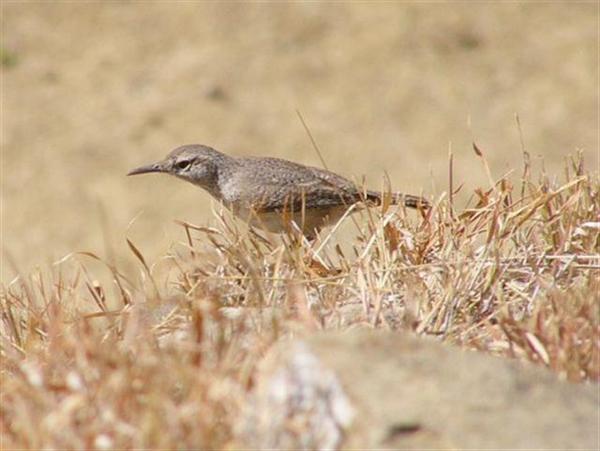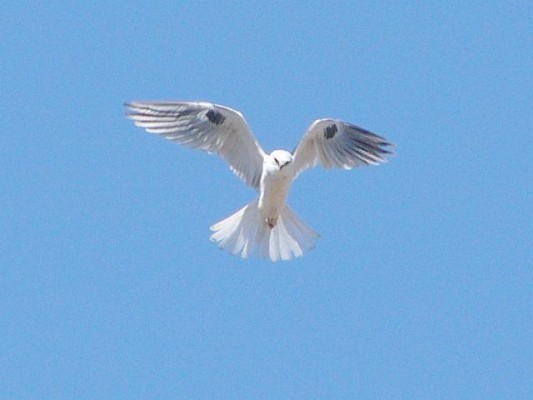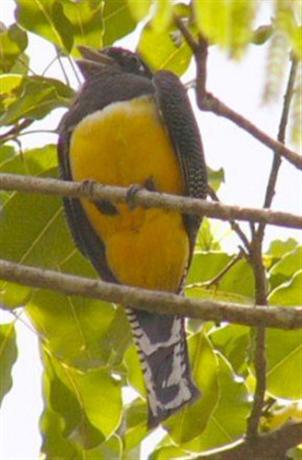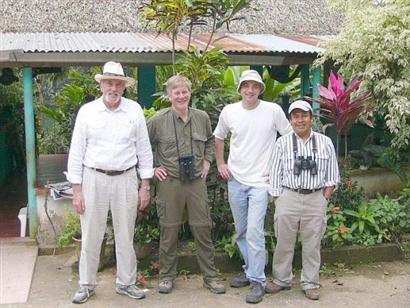Photos with this report (click to enlarge) | |||
 Rock Wren |
 White-tailed Kite |
 Violacious Trogon |
|
 Our birding group |
|||
Located in central Mexico , Oaxaca holds more bird species than any other state in the country . Due to it’s diverse habitats and geographic location , there is plenty of quality birding , spending a solid week there could easily yield 250+ species. Our trip started and ended in Oaxaca City , located in a dry interior valley of the Sierra Madre del Norte mountain range on the western side of the continental divide . My father Peter Bahr and I spent 5 full days birding with the hawk-eyed local guide Roque Antonio Santiago , other participants were Wink Gross and Becky Marsh from Portland Oregon and here is our report .
Pre-trip , 2-4-2006
We arrived at Oaxaca City Airport, which was the quietest airport I have ever been to in my life. Two planes were there, our plane which was landing and one which was parked outside of the terminal , the entire facilities was no larger than your average Lowe’s home center , no lines no fuss. Roque , our guide picked us up at the airport and taxied us around for the day.
We spent our first day downtown visiting some old friends of the family. We spotted a few birds in our travels, the brilliant Vermillion Flycatcher , Curve-billed Thrasher , and the abundant Wilson’s Warbler were the standouts. For the first few nights we stayed at Hotel Victoria on the outskirts of town where Western Tanager and Rufous-backed Robin were common behind the property.
7 species
4 Lifers
Bird of the Day: Vermillion Flycatcher
Day 1 , 2-5-2006 Monte Alban
Roque our guide picks us up before dawn for a drive to the Monte Alban Mayan Ruins located less than an hour south-west of downtown Oaxaca City .This was dry scrub habitat at 1800 meters elevation , and our first taste of how good Roque is as a professional in his craft . We worked the trails around the ruins and immediately started seeing birds. Our first birds were a handsome Black-throated Gray Warbler, Virginia Warbler, Orange-crowned Warbler and the very common Rufous-capped Warbler. Before the heat of the day we tallied several Flycatcher species including Nutting’s Flycatcher , also Hepatic Tanager , a stunning Bullock’s Oriole ,a skittish Blue Mockingbird and our first true endemic : Oaxaca Sparrow ! We continued to the top of the ruins where we saw a beautiful; male Townsend’s Warbler , a kiting Wite-tailed Kite , Clay-colored Sparrows and Rock Wrens on the upper sections of the ruins among the rocks and weeds . The Monte Alban facilities has guided historic tours of the ruins and a resturaunt , museum , and giftshop which makes for a pleasant and educational day trip for the non-birder.
31 species
25 lifers
Bird of the day: Oaxaca Sparrow
Day 2 , 2-6-2006 Teotetlan / Benito Juarez
This would turn out to be a stellar day of birding under very comfortable weather conditions. At the crack of dawn we piled into the van with Wink Gross, Becky Marsh and two other birders and headed for Teotetlan , located west of Oaxaca City at 1700 meters above sea level with marshy habitat ,open fields, and dry scrub trails .From this point forward Wink videotaped the trip and got some great footage as we continued on. There is great birding at Teotetlan with a higher diversity of species. In the early morning the hummers were very active and we found Dusky and Berryline Hummingbird very early. Around the marsy areas we got Common Moorhen, American Coot, Sora Rail. In the fields near the marsh were American Pipit and Horned Lark, although they are North American breeders, most of these were lifers for me. We missed a calling Marsh Wren. Some good birds along the trails were Bewick’s and Becards Wren, Golden Vireo, a smartly dressed Black Pheobe and a cooperative Greater Pewee.
After a few hours we traveled to an impoundment north of Teotetlan for waterfowl and whatever else we could dig up. Roque scoped a nice Bridled Sparrow and several new Flycatchers. I struck gold when I noticed a large bird near some thorny bushes, a wonderful Lesser Roadrunner! Roque worked him out of the bushes with his audio tapes and It stuck around long enough for us to get some decent photos and film footage.
We then headed uphill to a small mountain village called Benito Juarez located at almost 3000 meters . We had delicious fresh stream trout there at a small restaurant and then continued birding. The Flora here was mixed Pines and Oaks and the birds were different as well. Roque took us to some flowering shrubs where we were entertained by a Cinnamon-bellied Flowerpiercer being harassed by a Green Violet-ear Hummingbird; White-eared Hummingbirds were around as well. We walked the road and ran into mixed flocks of some very impressive species one after another – Slate-throated Redstart, Painted Redstart, Crescent-chested Warbler, Hermit Warbler , Hutton’s Vireo and the brilliant white cheeked Red Warbler. It was very birdy here but things finally cooled off a bit and then further down the road we hit Acorn Woodpecker, Black-eared Bushtit, and Roque caught a glimpse of an Amethyst-throated Hummingbird. We headed back to Hotel Victoria for our last night in the Central Valley after this terrific birding day.
91 species
49 Lifers
Bird of the day: Lesser Roadrunner
Day 3 , 2-7-2006 Ixtlan / Valle National
We departed Oaxaca City very early north on route 175 north on route to the western slope with Roque, Wink, Pete and myself . Our first stop was Ixtlan which was dry pine / oak on the western footlills of Sierra Madre Norte. Birding here was quiet and there was quite a bit of nearby roadside construction. We did manage to get a few new flycatchers and Rufous-crowned Sparrow. Moving along RT 175 north we stopped for brunch along the crest of the Sierra Madre mountain range and got Yellow-eyed Junco at a small restaurant. We then continued the dangerous winding road over the crest of the Sierra Madre and the Cloudforest and down the Caribbean slope to Valle National at 300 meters above sea level. This was our first look at tropical rainforest birding on the trip. The flora was completely different here with Banana trees, Umbrella trees , wild Cannas and a slew of flowering plants. Hummingbird species were different here as well with Canivet’s Emerald, Green-breasted Mango, and the abundant Rufous-tailed Hummingbird. We worked a descending trail with a good canopy view and soon found some fantastic new birds including the striking Crimson-collared Tanager,as well as Yellow-winged Tanager, Masked Tityra and Lineated Woodpecker. There was a slight misty rain which was very productive for birding and things were just about to get very interesting. While scanning the treeline a small red and black bird popped up in front of us on a branch not 15 ft away. Roque and I turned to eachother and whispered loudly “Red-capped Manakin" !! . It was a lifer for all of us , including our guide. A few branches away we realized a Violacious Trogon was quietly perched and finally flushed after all of the commotion. Other notable birds found at Valle National were Boat-billed Flycatcher , Squirrel Cuckoo ,Yellow-billed Cacique , Orange-fronted Parakeet and Golden-olive Woodpecker . We also heard Turquose-browed Motmot calling.Overnight in Tuxtepec.
45 species
26 Lifers
Bird of the day: Red-capped Manakin
Day 4 , 2-8-2006 Paso Canora / Soyaltepec
Morning started early as we loaded up on roadside chicken tamales and headed for the Caribbean lowlands of Paso Canora.The woods were alive with calling birds that reminded me of a big September migration day back in New Jersey. Roque instantly spotted a large flock of Montezuma’s Oropendulas as he was setting up his scope. We started finding birds soon after, a lot being species we had seen earlier and then some new ones. Collared Aracari , Blue-black Grossbeak , Altamira Orioles and then a stunning male Painted Bunting. Things slowed down a bit and we moved to a streamside location called Sierra del Oro. Along the way we found a majestic Gray Hawk soaring overhead. Sierra Del Oro yielded some nice new lowland birds including Limpkin, Little Blue Heron, and a trilogy of Kingfishers: Green, Ringed and Amazon Kingfisher. We then found Yellow-throated Euphonia, Scrub Euphonia , American Redstart and Golden-fronted Woodpecker. Around mid-day we traveled to Soyatepec for some lakeside birding, during the drive we came across a pair of Aplomado Falcons perched on a high-tension pole. When we arrived at the lake we had lunch at a small luncheonette and enjoyed fried fish that were caught in the lake, they were delicious with flaky white meat but looked prehistoric with large scales and wolf like jaws. It was one of the best meals of the trip. After lunch the weather was getting hot and muggy but the shoreline was busy with bird activity. Some of the birds here were White Pelican, Fork-tailed Flycatcher, Pied-billed Grebe, Glossy Ibis and Northern Jacana with striking lemon-yellow under wings. We stayed overnight in Tuxtepec where we heard Ferruginous Pygmy Owl calling and although we had heard them several times on the trip we never managed to see one. Overnight in Tuxtepec.
82 species
29 Lifers
Bird of the day: Painted Bunting
Day 5 2-9-2006 Tepezcuintle
Day 5 was our final day of birding and largely devoted to finding our target species, the endemic Sumichrast’s Wren. From the hotel in Tuxtepec we traveled to Tepezcuintle aka Roque’s private Sumichrast sanctuary. As soon as we got out of the truck Roque heard them vocalizing in the thickets. Working a dirt road near some limestone outcrops we began finding other birds. We spotted one of the finest hummingbird species I have ever seen, a very decorated male Black-crested Coquette. The bird was nectaring from morning glory blooms and it seemed to float in mid air like a fish on a coral reef.. The tiny Coquette’s style of flight was quite unlike any hummer I have ever seen, hovering more like an insect than a bird. We left the trail and headed up some deeply wooded paths in search of the Sumichrast Wren .It was then that I was buzzed by a Little Hermit who was inspecting some of the pins I had on my hat. It sounded like a helicopter was trying to land on my head! Finally after quite a bit of searching we all got a couple of peeks at the very secretive Sumichrast’s Wren. We continued birding in the under story and hiked up some dried-up creek beds, beautiful bromeliads were fixed in the trees. We found Olivacious and Streak-headed Woodcreepers working the tree trunks. Back on the dirt trail we found some Northeastern migrants like Louisiana Waterthrush , Yellow-breasted Chat , Black-throated Green Warbler and both Baltimore and Orchard Orioles . It was especially nice to get a good look at a foraging Long-billed Gnatwren in the thickets on the walk back to the truck. The trip was winding down for us and we knew we had to take the long drive back to Oaxaca City , on the way back we stopped at a roadside restaurant called “El Turcos” for lunch where a stuffed Mottled Owl was on a display shelf .The owner said the owl was hit by a car and they decided to stuff it , that was the closest we got to seeing any owls on the trip ! We drove back onto RT 175 and took the treacherous mountain pass road home which had dead man’s curves and roadside graves every few miles from cars falling off the road and crashing on the cliffs below. The road becomes especially dangerous when it passes thru the clouds and visibility can be 20 yards or less. We took a small bathroom break at one of these cloud locations and heard Clay-colored Solitare calling. By the time we made it to Oaxaca City limits the sun had already set and it seemed like our birding had come to a close. However, we had one more surprise as a Mexican Whip-poor-will was perched on the roadside and Roque spotted it. We slowed down to a stop and it did not flush in the headlights so we got a nice look at our going away present.
41 species
14 Lifers
Bird of the day: Sumichrast’s Wren
Trip totals :
199 species seen + 7 heard
147 lifers
Acorn Woodpecker
Altamira Oriole
Amazon Kingfisher
American Coot
American Kestrel
American Pipit
American Robin
American Redstart
Aplomado Falcon
Bannaquit
Baltimore Oriole
Berryline Hummingbird
Becard's Wren
Bewick's Wren
Black Pheobe
Black Vulture
Black-bellied Whistling Duck
Black-crested Coquette
Black-headed Saltator
Black-eared Bushtit
Black-necked Stilt
Black-throated Gray Warbler
Black-throated Green Warbler
Black-vented Oriole
Blue Grosbeak
Blue Ground-Dove
Blue Mockingbird
Blue-black Grosbeak
Blue-black Grassquit
Blue-gray Gnatcatcher
Blue-gray Tanager
Blue-winged Teal
Boat-billed Flycatcher
Boucard's Wren
Bridled Sparrow
Brown-crested Flycatcher
Brown Jay
Bullock's Oriole
Canivet's Emerald
Cassin's Kingbird
Cattle Egret
Chestnut Oropendula
Chipping Sparrow
Cinnamon Teal
Cinnamon-bellied Flowerpiercer
Clay-colored Robin
Clay-colored Sparrow
Collared Aricari
Common Moorhen
Common Snipe
Common Yellowthroat
Couch's Kingbird
Crescent-chested Warbler
Crested Caracara
Crimson-collared Tanager
Curve-billed Thrasher
Dusky Flycatcher
Dusky Hummingbird
Fork-tailed Flycatcher
Fulvous Whistling-Duck
Glossy Ibis
Golden Vireo
Golden-fronted Woodpecker
Golden-Olive Woodpecker
Gray-breasted Woodpecker
Great Blue Heron
Great Egret
Great-tailed Grackle
Greater Pewee
Greater Kiskadee
Green Heron
Green Kingfisher
Green-breasted Mango
Green-violetear
Green-winged Teal
Grey Hawk
Groove-Billed Ani
Hepatic Tanager
Hermit Thrush
Hermit Warbler
Hooded Warbler
Horned Lark
House Sparrow
House Wren
Hutton's Vireo
Inca Dove
Indigo Bunting
Keel-billed Toucan
Lark Sparrow
Laughing Gull
Least Flycatcher
Least Grebe
Least Sandpiper
Lesser Roadrunner
Lesser Goldfinch
Lesser Scaup
Limpkin
Lineated Woodpecker
Little Blue Heron
Little Hermit
Long-billed Dowitcher
Long-billed Gnatwren
Louisiana Waterthrush
Magnolia Warbler
Mangrove Swallow
Masked Tityra
Melodious Blackbird
Mexican Junco
Mexican Whip-poor-will
Montezuma Oropendula
Nashville Warbler
Neotropic Cormorant
Northern Jacana
Northern Mockingbird
Northern Parula
Northern Pintail Duck
Northern Raven
Nutting's Flycatcher
Oaxaca Sparrow
Olivaceous Woodcreeper
Orange-crowned Warbler
Orange-fronted Parakeet
Orchard Oriole
Osprey
Painted Bunting
Painted Redstart
Pied-billed Grebe
Red Warbler
Red-billed Pigeon
Red-capped Manakin
Red-lored Parrot
Red-throated Ant-tanager
Ringed Kingfisher
Ring-necked Duck
Roadside Hawk
Rock Wren
Rose-breasted Grossbeak
Rough-winged Swallow
Ruby-crowned Kinglet
Ruddy Duck
Ruddy Ground-Dove
Rufous-backed Robin
Rufous-capped Brushfinch
Rufous-capped Warbler
Rufous-crowned Sparrow
Rufous-tailed Hummingbird
Say's Pheobe
Scrub Euphonia
Scrub Jay
Sepia-capped Flycather
Sharp-shinned Hawk
Slate-throated Redstart
Snowy Egret
Social Flycatcher
Sora Rail
Spot-breasted Wren
Spotted Sandpiper
Squirrel Cuckoo
Streak-headed Woodpecker
Sumichrast's Wren
Summer Tanager
Thick-billed Seedeater
Townsend's Warbler
Tri-colored Heron
Tropical Kingbird
Tufted Flycatcher
Turkey Vulture
Vermillion Flycatcher
Violet-green Swallow
Virgina Warbler
Western Kingbird
Western Tanager
White Pelican
White-bellied Emerald
White-collared Seedeater
White-crowned Parrot
White-eared Hummingbird
White-eyed Vireo
White-fronted Parrot
White-tailed Hawk
White-tailed Kite
White-throated Swift
White-throated Towhee
White-winged Dove
Wilson's Warbler
Yellow Warbler
Yellow-bellied Flycatcher
Yellow-billed Cacique
Yellow-breasted Chat
Yellow-rumped "Audubon's" Warbler
Yellow-throated Euphonia
Yellow-winged Tanager
Seen by others but not myself:
Amythest-throated Hummingbird
Blue-headed Grosbeak
Blue-winged Warbler
Buff-throated Saltator
Blue-ground Dove
Nashville Warbler
heard only:
Marsh Wren
Clay-colored Solitare
Ferriginous Pygmy Owl
Rufous-breasted Spinetail
Emerald Toucanette
Turquoise-browed Motmot